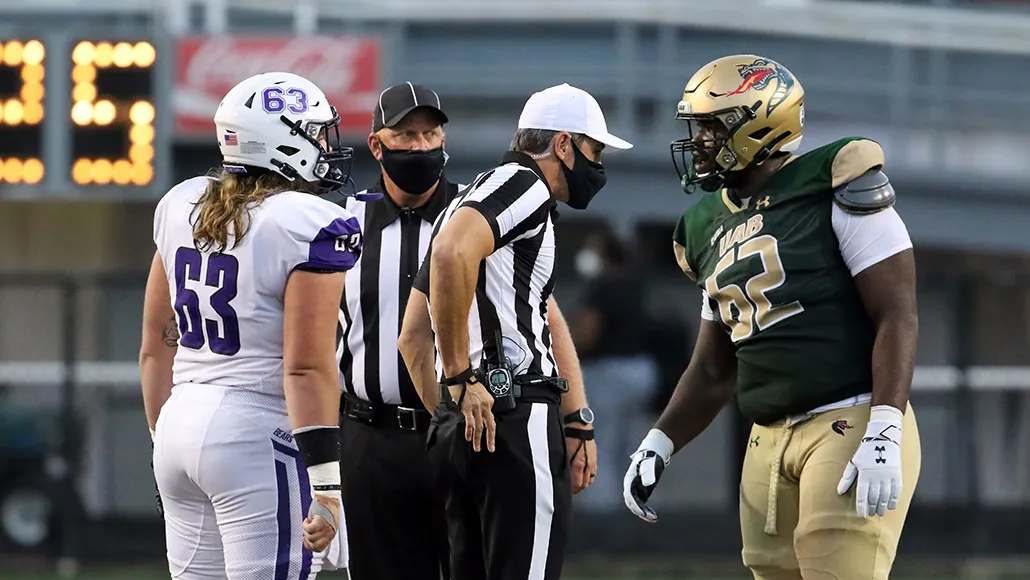College athletes show signs of possible heart injury after COVID-19
A small study found indicators of inflammation in images of some athletes’ hearts

Even as some college athletic conferences go ahead with fall sports, others have postponed their seasons, citing safety concerns related to COVID-19. A small study of recovered college athletes found that four of 26 showed signs of heart inflammation.
Icon Sportswire/Getty Images
- More than 2 years ago
Amid growing concerns that a bout of COVID-19 might damage the heart, a small study is reporting signs of an inflammatory heart condition in college athletes who had the infection.
More than two dozen male and female competitive athletes underwent magnetic resonance imaging of their hearts in the weeks to months after a positive test for SARS-CoV-2, the virus that causes COVID-19. The images indicated swelling in the heart muscle and possible injury to cells in four of the athletes, or 15 percent, researchers report online September 11 in JAMA Cardiology. That could mean the athletes had myocarditis, an inflammation of the heart muscle most frequently caused by viral infections.
Heart images of eight additional athletes showed signs of possible injury to cells without evidence of swelling. It’s more difficult to interpret whether these changes in the heart tissue are due to coronavirus infection, says Saurabh Rajpal, a cardiologist at the Ohio State University Wexner Medical Center in Columbus. One limitation of the research is the lack of images of the athletes’ hearts prior to the illness for comparison, Rajpal and his colleagues write.
None of the 26 athletes in the study, who play football, soccer, basketball, lacrosse or run track, were hospitalized due to COVID-19. Twelve of the 26, including two of the four with signs of inflamed hearts, reported mild symptoms during their infection, such as fever, sore throat, muscle aches and difficulty breathing.
It will take more research to confirm the study’s findings and understand what they could mean for these young hearts. For now, the results suggest the heart may be at risk of injury, and serve as a reminder that after having COVID-19 — even with mild or no symptoms — young people need to pay close attention to how they are feeling when they return to exercise, says Rajpal. If they have symptoms like chest pain, shortness of breath or an abnormal heart beat, he says, they should see a doctor.
It’s been apparent since early in the pandemic that COVID-19 can be worse in patients who already have heart problems (SN: 3/20/20). More recently, studies have reported on what the infection might do to the heart. For example, researchers assessed 100 German adult patients who’d recovered from COVID-19, one third of whom needed to be hospitalized. Cardiac MRIs revealed signs of heart inflammation in 60 of these patients after their infection.
Those signals of heart inflammation could mean that the patients had developed myocarditis, which is estimated to occur in approximately 22 out of 100,000 people annually around the world. Patients with myocarditis can experience chest pain, shortness of breath, fatigue or a rapid or irregular heartbeat. The heart can recover from myocarditis, but in rare cases, the condition can damage the heart muscle enough to lead to heart failure.
Sign up for our newsletter
We summarize the week's scientific breakthroughs every Thursday.
For athletes diagnosed with myocarditis, the recommendation is to stop participating in sports for three to six months to give the heart time to heal, as animal evidence suggests that vigorous exercise when the heart is still inflamed worsens the injury. With a break from sports, young athletes can expect to recover from myocarditis. But the condition is taken seriously: A 2015 study estimated that 10 percent of sudden cardiac deaths in NCAA athletes were due to myocarditis. When the Big Ten Conference, which includes Ohio State, announced in August that it was postponing its football season, one of the reported reasons was concerns about COVID-related myocarditis.
This new study of college athletes and COVID-19 “is really a step in the right direction,” says Meagan Wasfy, a sports cardiologist at Massachusetts General Hospital. “We need more data like this.” But it’s hard to draw firm conclusions from the findings, she says. Cardiac MRI usually is used to confirm a diagnosis of myocarditis in combination with other clinical signs, including symptoms, blood test results that signal inflammation, high levels of a protein called troponin I that indicates stress on the heart and abnormal findings in an electrocardiogram.
In the study, while some athletes had signs of possible myocarditis in imaging, their troponin I levels were normal, and their electrocardiograms didn’t look unusual. Wasfy sees a few possible explanations. Had the athletes been tested when they were first infected, those other clinical signs might have shown up. Perhaps the other indications had returned to normal by the time the cardiac MRI and other tests were performed. In that case, the MRI is a “ghost” of that prior inflammation and stress, she says.
Another possibility is that SARS-CoV-2 is impacting the heart muscle in a way that cardiologists aren’t accustomed to, absent some of the usual signs of inflammation and stress. Without those indicators of myocarditis, it’s hard to say if the heart had this condition, she says.
Some might argue that the imaging signs could be chalked up to differences between the hearts of competitive athletes and those of the more sedentary. Wasfy thinks that’s less likely, but cardiologists “certainly have a lot of work to do to define what the prevalence of these [imaging] findings is at baseline” in healthy athletes.
To expand on the study, Rajpal and his colleagues plan to take heart scans of more athletes, repeat cardiac MRIs in the athletes already imaged, and scan athletes who did not have COVID-19 to compare their images with those who have.







